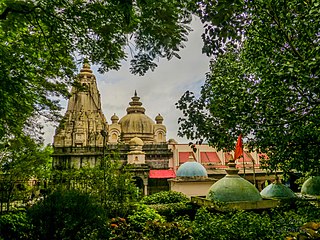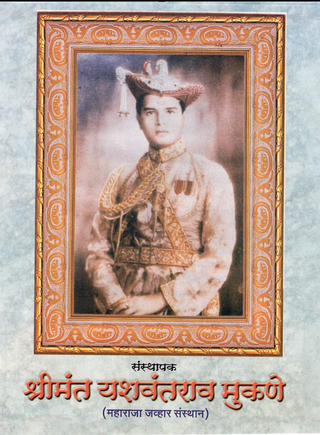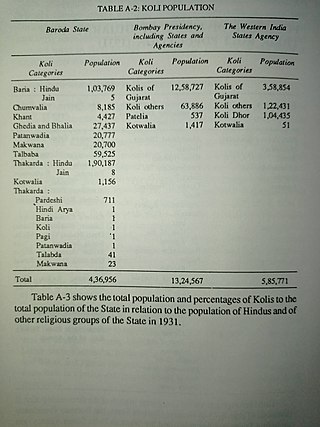
Thane district is a district in the Konkan Division of Maharashtra, India. At the 2011 Census it was the most populated district in the country, with 11,060,148 inhabitants; however, in August 2014 the district was split into two with the creation of a new Palghar district, leaving the reduced Thane district with a 2011 census population of 8,070,032. The headquarters of the district is the city of Thane. Other major cities in the district are Navi Mumbai, Kalyan-Dombivli, Mira-Bhayander, Bhiwandi, Ulhasnagar, Ambarnath, Badlapur, Murbad and Shahapur.

Palghar is a prominent town in the Konkan division of Maharashtra state, India, and a municipal council. It is Strategically located within the Mumbai Metropolitan Region, and since 2014, it has been the administrative capital of the Palghar district. Palghar plays a crucial role in Western Line of the Mumbai Suburban Railway in the busy Mumbai-Ahmedabad rail corridor. The town is located approximately 87 kilometers north of Mumbai, about 35 kilometers north of Virar, and about 24 kilometers west of the Mumbai-Ahmedabad National Highway at Manor and Mumbai is approximately 50+ km from Palghar.
Parmar, also known as Panwar is a Rajput clan found in Northern and Central India, especially in Rajasthan, Gujarat, Punjab, Haryana, Uttarakhand, Uttar Pradesh, Bihar,Jharkhand, Madhya Pradesh and North Maharashtra. The Panwar ruled in Ujjain and later in Dhar.
The Nayak, or Naik is a historic honorific title conferred on military captains and governors of feudal states in the Middle Ages. Today it is also a surname. Nayaks are mostly Hindu and few Sikhs, who follow Hinduism and Sikhism respectively.

Dahanu is a coastal town and a municipal council in Palghar district of Maharashtra state in Konkan division. It is located 110 km from Mumbai city and hosts Adani Power’s thermal power station. It is the site of the approved Vadhawan Deep Water Port.

The Warli or Varli are an indigenous tribe (Adivasi) of western India, living in mountainous as well as coastal areas along the Maharashtra-Gujarat border and surrounding areas. They have their own animistic beliefs, life, customs and traditions, and as a result of acculturation they have adopted many Hindu beliefs. The Warli speak the unwritten Varli language which belongs to the southern zone of the Indo-Aryan languages. Waralis have sub castes such as Murde varli, Davar varali.

Warli painting is tribal art mostly created by the tribal people from the North Sahyadri Range in Maharashtra, India. Warli paintings exist in cities such as Dahanu, Talasari, Jawhar, Palghar, Mokhada, and Vikramgad of Palghar district, and originated in Maharashtra, where it is still practiced today.
The Jadhav is an clan (Gotra) found in the several castes such as Koli, Maratha, Banjara and Mangs living in Indian states of Maharashtra, Goa, Karnataka, Telangana

The Rathva or Rathwa is a Subcaste of the Koli caste found in the Indian state of Gujarat. Rathava Kolis were agriculturist by profession and turbulent by habits but now lives like Adivasis such as Bhil because of their neighborhood
The Kotwal also spelled as Cotwal, or Kotval, was a title used in medieval and early modern period for the leader of a Kot or fort. Kotwals often controlled the fort of a major town or an area of smaller towns on behalf of another ruler. It was similar in function to a British Indian Zaildar From Mughal times the title was given to the local ruler of a large town and the surrounding area. However, the title is also used for leaders in small villages as well. Kotwal has also been translated as Chief police officer. The post of Kotwal was known since ancient times as Kota pala who was the chief of Police.

The Mahawar Koli is a subcaste of the Koli people. They are present in the Indian states of Rajasthan, Punjab, Haryana, Uttar Pradesh, Madhya Pradesh, and the capital territory of Delhi. Mahawar Kolis inter-marry with Shakya Kolis but not with any other Koli subcastes. Together with other Koli subcastes, the Shakyawar, Jaiswar, Kabirpanthi, and Shankhwar Kolis of Uttar Pradesh, the Mahawar Kolis worked to uplift Koli social status in Hindu society by supporting the "All India Kshatriya Koli Mahasabha" leaders of Ajmer.

The Koli is an Indian caste found in Rajasthan, Himachal Pradesh, Gujarat, Maharashtra, Uttar Pradesh, Haryana, Karnataka, Odisha and Jammu and Kashmir states in India. Koli is an agriculturist caste of Gujarat but in coastal areas they also work as fishermen along with agriculture. In the beginning of 20th century, the Koli caste was recognised as a denotified tribe under Criminal Tribes Act by the Indian Government because of their anti-social activities during World War I.

Yashwantrao Martandrao Mukne (V) was a Koli Maharaja of Jawhar State, a flight lieutenant in the Royal Indian Air Force, politician, social worker and a former Member of Parliament from Bhiwandi for the 3rd Lok Sabha and Dahanu for the 4th Lok Sabha as a member of the Indian National Congress.

Palghar District is a district in the state of Maharashtra in Konkan Division. The headquarters of the district is the town of Palghar. Other major cities in the district are Vasai-Virar, Talasari, Jawhar and Dahanu.

Surgana State was a princely state of the Bombay Presidency during the era of the British Raj. It was the only state belonging to the Nasik Agency. Its capital was Surgana in Nashik District of present-day Maharashtra. It was ruled by Kolis of Pawar dynasty.

The Mahalakshmi temple, or Mahalaxmi Temple, is a temple situated on the Mumbai–Ahmedabad Highway in Dahanu taluka, Palghar, Maharashtra, India. It is dedicated to Mahalakshmi. This temple was built by Koli king Jayaba Mukne of Jawhar State in 1306 at the establishment of Jawhar. During the worship, the flag of the present Raja of Mukne Dynasty of Jawhar is offered to the mother's temple. The flag is presented by Narayan Satava, the priest of the village of Vaghadi.

Bapuji Bhangare was a Koli Patil of Deogaon and Indian freedom fighter who challenged the British government in Maharashtra state of British India. Bapuji Bhangare breakdown the British government strongly in Pune, Ahmadnagar and Nashik districts of Maharashtra.

The Talapada Koli, or Talpada Koli, is a subcaste of the Koli caste of Gujarat state in India. Talapada Kolis are agriculturists by profession. they were members of the Gujarat Kshatriya Sabha, an organisation launched by Natwarsinh Solanki who was a Koli elite. In 1907, they were classified by the British as a Criminal Tribe, ascribing to them a range of anti-social activities such as highway robbery, murder, and theft of animals, cattle and standing crops. They were also alleged to be blackmailers and hired assassins.
The Son Koli, or Sona Koli is a subcaste of the Koli caste found in the Indian state of Maharashtra. The Son Kolis are the original residents of what is now Mumbai, the capital of Maharashtra. They practice both Hinduism and Christianity because Son Kolis were converted to Christianity during the Portuguese rule in India and worship Our Lady of Mount and Hindu deities. Historically, the Son Kolis have been fisherman by profession.













